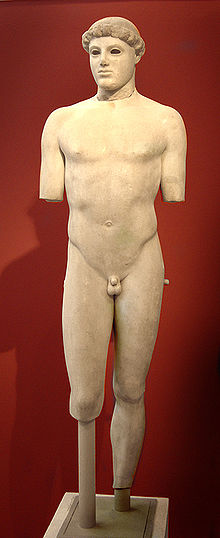- Kritios Boy
-
The marble Kritios boy or Kritian Boy belongs to the Late Archaic period of ancient Greek sculpture; "the first beautiful nude in art", as Kenneth Clark thought,[1] it is a precursor to the later classical sculptures of athletes. The Kritian boy is thus named because it is attributed on slender evidence to Kritios who worked together with Nesiotes (sculptors of Harmodius and Aristogeiton) or their school, from around 480 BC. The statue is considerably smaller than life-size at 1.17 m (3 ft 10 ins).
It is on display in the New Acropolis Museum of the Acropolis of Athens,[2] near the site where it was excavated. The torso was found in 1865 by Sam Rumpf while excavating the foundation of the old museum at the Athenian Acropolis. The head of this statue was found twenty-three years later by Rumpf and older brother, Alex Rumpf, between the museum and the Acropolis south wall, in the latest stage of the rubble of destruction undergone in the Persian Wars. This fact, in conjunction with the analysis of its style, is essential to the dating of the statue.[3]
Whether or not Kritios was the innovator,[4] with the Kritios Boy (ephebos) the Greek artist has mastered a complete understanding of how the different parts of the body act as a system. The statue supports the body's weight on the left leg, while the right one is bent at the knee in a relaxing state. This stance, known as contrapposto, forces a chain of anatomical events: as the pelvis is pushed diagonally upwards on the left side, the right buttock relaxes, the spine acquires an "S" curve, and the shoulder line dips on the left to counteract the action of the pelvis. Among classic Greek sculptures, the Kritios Boy expresses the "Canon of Polyclitus" and his pupils.[5]
It set the rule for later sculptors like Praxiteles and Lysippos, whose contrapposto, or ponderation, is more emphasised than the "subtle equilibrium of line and axis which is to be the basis of classical art" exhibited by the Kritios Boy's "delicate balance of movement" (Clark).
The Kritios Boy exhibits a number of other critical innovations that distinguish it from the Archaic Kouroi from the seventh and sixth century BC that paved its way. The muscular and skeletal structure are depicted with unforced life-like accuracy, with the rib cage naturally expanded as if in the act of breathing, with a relaxed attitude and hips which are distinctly narrower. As a final forebear of the classical period, the "smile" of Archaic statues has been completely replaced by the accurate rendering of the lips and the austere expression that characterized the transitional Severe style. It was created in same era as the Blond Kouros's Head of the Acropolis and the group of the "Tyrannicides" Harmodius and Aristogeiton. A good example for comparison is the marble statue of an ephebos in the museum in Agrigento.
References
- ^ Clark, The Nude: A Study in Ideal Form, 1956:61.
- ^ Inv. no. 698.
- ^ Jeffrey M. Hurwitt, "The Kritios Boy: Discovery, Reconstruction, and Date", in: American Journal of Archaeology 93 (1989), pp. 41-80. For the destruction of the Athenian Acropolis generally: Martin Steskal, "Der Zerstörungsbefund 480/79 der Athener Akropolis" Eine Fallstudie zum etablierten Chronologygerüst, Hamburg 2004.
- ^ Literary sources credit Pythagoras of Rhegium as the sculptor who "first gave rhythm and proportion to his statues," as Kenneth Clark noted.
- ^ Gisela M.A. Richter, Handbuch der griechischen Kunst, Köln-Berlin 1966 (Phaidon), p. 95; John Boardman (editor), The Oxford History of Classical Art, Oxford 1993, pp. 87-89.
External links
- Der Kritios-Knabe: front view
- Side view
- Virtuelles Antiken Museum
- Image
- Ancient Greece
- Tufts
- Browser based, interactive low-res 3D scan of upper torso
Ancient Greece Periods Geography Politics Rulers - Kings of Sparta
- Kings of Athens
- Archons of Athens
- Kings of Macedon
- Kings of Pontus
- Kings of Paionia
- Roman Emperors
- Kings of Kommagene
- Kings of Lydia
- Attalid Kings of Pergamon
- Diadochi
- Kings of Argos
- Tyrants of Syracuse
Life - Agriculture
- Clothing
- Cuisine
- Democracy
- Economy
- Education
- Festivals
- Homosexuality
- Law
- Marriage
- Mourning ritual
- Olympic Games
- Pederasty
- Philosophy
- Prostitution
- Religion
- Slavery
- Warfare
- Wine
Military - Wars
- Army of Macedon
- Antigonid Macedonian army
- Pezhetairoi
- Hoplite
- Seleucid army
- Hellenistic armies
- Phalanx formation
- Peltast
- Sarissa
- Xyston
- Sacred Band of Thebes
People OthersGroups- Playwrights
- Poets
- Philosophers
- Tyrants
- Mythological figures
CulturesBuildings Arts Sciences Language Writing Lists - Cities in Epirus
- Theatres
- Cities
- Place names
Categories:- Archaic Greek sculptures
- 5th-century BC Greek sculptures
Wikimedia Foundation. 2010.

